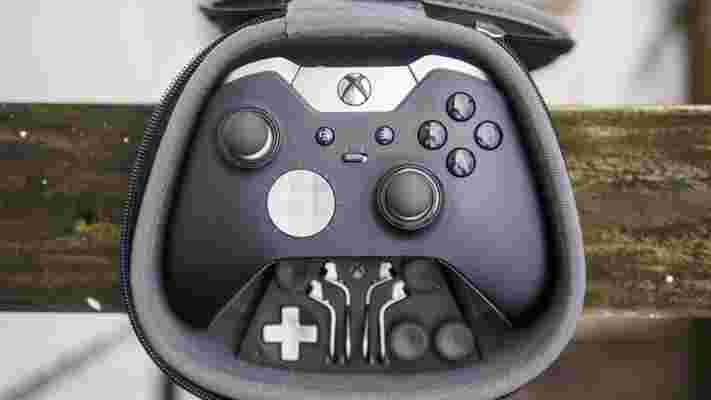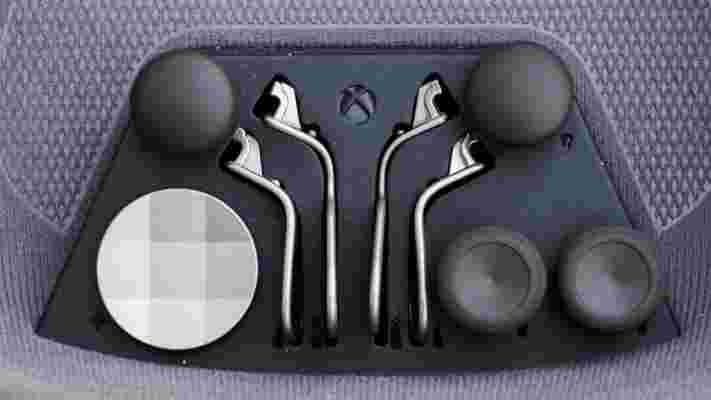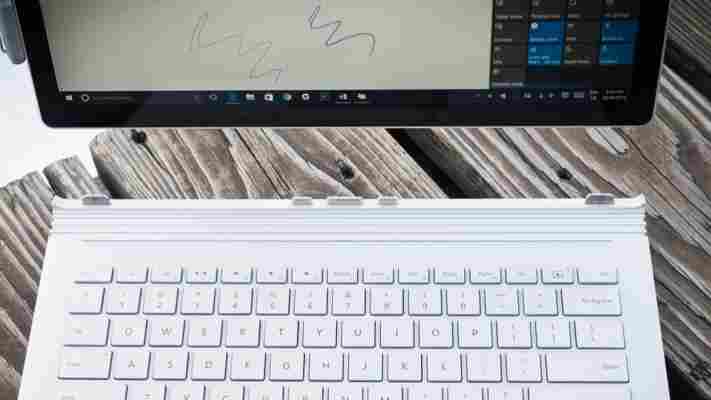The Xbox One Elite Controller review

You probably don’t need a $150 controller.
That’s the first thing you need to remind yourself when considering the Xbox One Elite controller (which also works for PCs). For the average gamer, chances are spending $150 on a controller – no matter how nice it is – is not the most reasonable choice.
Spend a few minutes with it, however, and you’ll sure as heck want one. And if you’re a professional or just someone who takes his performance seriously enough that the price tag doesn’t already turn you away, there’s simply no better option out there.
If you’re not familiar, the Xbox Elite controller brings a plethora of customization features over the standard Xbox One pad. It’s aimed squarely at the most serious of gamers – so much so that it doesn’t even bother color coding its face buttons for newbs.
Of course, third-party manufacturers have been trying to one-up official controllers with extra features for decades – including some current alternatives – but it’s pretty much universally accepted that official controllers are just better.
That’s what makes the Xbox Elite controller special: this possibly the first time in gaming history that a console manufacturer hasn’t just upgraded or replaced an official controller with new features meant for new games, but rather flat-out constructed an unquestionably better controller. This is a luxury item through and through.
But luxury isn’t to say the upgrades aren’t useful if you’re a serious gamer. In fact, every single one is useful and well thought out.


Perhaps most notably, the analog sticks and D-Pad are interchangeable and removable. The box comes with three pairs of sticks, the idea being they provide varying degrees of accuracy, grip, and responsiveness.
Short concave (essentially the same as those on the standard controller)
Medium convex: similar to PlayStation thumbsticks, these provide a smoother grip.
Long convex: A longer version of the original thumbsticks.
The longer thumbsticks provide greater control for making small, precise movements, while the shorter lengths are better for quick responsive movements. You might also prefer the larger thumbsticks if you have smaller hands.
You can mix and match too, and it’s easy to do on the fly; the thumbsticks are attached magnetically, and you simply pull them off. Despite how easy they are to remove, I never felt they might fly off during intense gaming sessions, although you may want to watch out around pets and children.
Generally, I gravitated towards the medium length with the smooth tops, but in shooting games, I found myself liking the shorter analog sticks for moving my characters, and using the long one for aiming. I’ll always vouch for mouse-and-keyboard’s superiority in FPS titles, but the long analog stick definitely helps here.
Likewise, the d-pad can be switched between a traditional cross shape and a faceted jewel-looking pad. I preferred the latter but it feels a little looser than the alternative if you press it too hard.
Then there are the totally new inputs, comprised four detachable paddles around the grip. These can be assigned to the variety of inputs, and allow you to perform actions without taking your hands off of the thumbsticks. Unfortunately, they can’t be assigned to macros (input combinations), which seems like a major missed opportunity. Hopefully that functionality comes via a software update.
Finally, a pair of locks reduce the range of motion on the triggers to about half their usual distance; that makes them more responsive for quick repetitive actions.
In fact, this was one of the most useful adjustments for me; the standard trigger setting was preferable for racing games where you want additional control, but the short triggers definitely came in handy for shooters like ‘Gears of War’ and platformers like ‘Mirror’s Edge’ (a 360 title now playable on the Xbox One thanks to recently-added backwards compatibility ), where you’re more concerned with quick actions than finesse.
It’s not all hardware though; he new Xbox Accessories app allows you remap pretty much every button on the controller to every other button, and even set presets for specific games.
Plenty of games allow you to remap buttons, so the analog stick response settings might prove more useful for competitive players. Rather than just providing a sensitivity value – which you’ll still have to adjust in-game – Microsoft actually allows you to change the sensitivity curve , including 5 different options you can test right in app.
For example a ‘Delay’ setting provides more precise, slower movement in the central portion of the analog stick over the default setting, forcing you to move all the way to the outer rim to move quickly. Meanwhile, an ‘Instant’ setting has an opposite effect, nearly maxing out your character’s speed with just a light tap.
Other custom settings include adjusting the dead zones on the trigger
That said, customization is only temporarily exclusive to the Xbox Elite controller; Microsoft says the Xbox Accessories app will soon be compatible with standard controllers, although it’s not clear to what extent. The Elite model also has the advantage of a configuration switch right on the controller, allowing you to change profiles on the fly.
Do all these features improve your gameplay? Well, yes, anecdotally speaking. I found myself frequently switching analog sticks on the fly – sometimes within the same game – and playing around with the different sensitivity profiles. I personally didn’t find much use for the paddles, but it’s not hard to see how they’ll come in handy for more advanced gamers.
My singular serious qualm is that rechargeable batteries aren’t included in box. That’s not to say I don’t think AA batteries were the right choice; it’s much easier for someone in a tournament to simply swap out a pair of batteries than having to completely recharge a controller. But it wouldn’t been nice for these to be of the rechargeable variety for everyday use at home.
So the question remains: should you buy it?
That depends on how you game. Do you go to tournaments and spend hours on Twitch? Do you have a lot of cash to burn? Then it’s a worthwhile investment, particularly given it feels built to last. And if you’re buying a new console, shelling out for the $499 Elite Bundle is worth the premium for the combination of the new controller and 1TB of storage.
For everyone else, it’s not suddenly going make you a l33t h4x0r esports champion. The TL;DR amounts to this: the Xbox Elite Controller is probably the best traditional console controller ever made, but it’s also the gaming equivalent of buying nice sports gear: it won’t give you a significant edge if you’re not already really good, but it’ll make you feel like you have one.
And sometimes that enough.
➤ Xbox One Elite Controller
The Surface Book has an amazing feature no one’s talking about: User upgradability
Microsoft’s Surface Book is an awesome laptop. Zany design and detachable screen aside, one of the main reasons for that is that it manages to squeeze a discrete GPU into a laptop the size and weight of a 13-inch MacBook Pro.

But while the laptop has received a ton of praise, there’s one undisclosed feature most reviewers haven’t mentioned that will make many spec nerds happy: the Surface Book lets you upgrade your graphics card – and overall performance – on the fly.
Well, sort of. Microsoft hasn’t given any indication it will sell its keyboard bases separately, but the company confirmed to me that even if you have the lowest-end i5 model without discrete graphics, you can simply swap in the base with discrete graphics to speed up your laptop for intensive applications and games.
Indeed, PC World tested upgrading its mid-tier Surface Book with the base from the high-end model, and it worked without a hitch.


For power users, that’s a huge deal. A few months ago, I wrote about why Microsoft should release a graphics dock for the Surface Pro, and with the Surface Book, it’s basically taken a modified approach to my suggestion.
Imagine if when the Surface Book 2 comes out, you could upgrade to a more powerful graphics chip and USB-C ports by simply swapping out the base?
Or better yet, what if Microsoft managed to release a more powerful Surface Dock using the Surface Book’s connector that allowed you to pair the system with a desktop-class GPU, complete with its own cooling system?
After all, while the mystery GPU in the Surface Book (it appears to be a modified Nvidia 940M ), is certainly better than pretty much any ultrabook out there (AKA no integrated graphics at all), Microsoft was likely limited in how much power it could fit in the base by thermal, size and weight requirements.
The company could even simply open up the port to third parties and let them handle creating the accessory hardware. It doesn’t even have to be just graphics – perhaps just extra ports like USB-C or HDMI.
The possibilities are endless, and it makes the gamer in me feel giddy. And as I mentioned it my original Surface Dock post, it’s not just games that benefit – tons of professional applications like Adobe Lightroom and After Effects or AutoDesk CAD use GPU acceleration to boost performance.
Of course, everything in this post is for naught if Microsoft doesn’t consider offering the base for sale separately, let alone creating my fanciful desktop GPU dock. For that to happen, the Surface Book will likely have to sell well enough for the company to consider upgraded graphics to be profitable.
Still, the fact that it’s feasible at all is just another reason why the Surface Book is one of the most exciting laptops released in years. Here’s to hoping Microsoft takes the hint and brings the platform to its fullest.
Anki’s new robot car racing game totally blew me away by bridging the digital and real world
Try as I might, it’s hard to keep up with every single gadget/device/connected toy released, and Anki’s Drive racing game totally passed me by first time around.

However, the company has just released its second robot racing game in the form of Anki Overdrive , which is partially compatible with the existing Drive track and cars.
In a nutshell, it’s like a 21st Century version of Scalextric , but one that turns it into feeling like a hybrid between a video game and a real-world game.
In the Anki Overdrive Starter Kit, there’s a few sections of track (10), two cars and a charging pad for the vehicles.
Opening it up, I had flashbacks to spending hours setting – and then re-configuring – Scalextric sets when I was younger. I’ll be honest, it didn’t make me want to leap straight in.
Thankfully, it’s a whole different system – and it’s exceptionally easy to get up and running in just a few minutes.
To create a track, you simply click the magnetic sections together, and because it doesn’t need any sort of power, it doesn’t need to be plugged into the wall so you can put it wherever you like.
Changing configurations is simply the case of spending a minute or two adjusting the track, and then carrying on with your racing.
You’ll need to charge the cars before you can use them for the first time too, but again, this is a quick process – from flat to fully charged in around 10 minutes, which minimises downtime between rounds.
Once you’re ready to start and have downloaded Anki Overdrive for your Android or iOS device , the app will guide you through the rest of the connection process (and prompt you to switch on Bluetooth, if it isn’t already).
The first time you place the cars on the track during the pre-race set-up, something really pleasing happens: the cars shoot off to scan the track, automatically driving themselves to optimize for your layout. Once that’s done, they both automatically pull up at the Start line, ready to begin the race.
This last bit brought a smile to my face instantly, piquing my excitement to get racing.
The ‘big secret’ (not at all a secret) about Anki Overdrive is that a large part of the driving is automated – your car will happily navigate its own way around the track without your interference at all, but you get to control the speed and can change lanes by tilting your phone from side to side.
You might want to change lanes to tactically line yourself up with your rival, or you might want to just try and smash them off the track as you go around a corner.
At this stage, I was already impressed and having fun – and then the tutorial introduced weapons.
That’s right, you get an array of virtual weapons to help you win in battle and race mode.
Each vehicle also has a few different weapons available to it. Using a ‘tractor beam’ to draw your rival in, followed by a ‘stun’ so you can go whizzing past is as much fun as it sounds, and that was just me playing against the AI. With a group of friends, it’d be even more enjoyable, no doubt.
It was this addition of weapons that really blew me away, instantly creating a unique gaming sensation that I’d not had before. Sure, I’ve always been a (console) gamer and play on my phone but Overdrive instantly paired my nostalgia for Scalextric with modern gaming.
Control of the cars isn’t a completely precise affair, but lane and speed changes happen quickly enough for you to know that you’re in control. Hint: You’ll often need to slow down to maneuver yourself into a position to take down your rivals.
The way in which the modular weapons system works means there’s enough variety to keep you playing, even if you’re on your own. There’s also a tournament mode, as well as one-off races.
To help ensure you don’t get bored, you can buy expansion packs with additional bits of track, different cars, risers to create height and a few other bits and pieces.
The only slight downside of the Overdrive setup that I’ve found so far is that the cars need to scan the track for a couple of laps between each race, which slows things down a little bit if you’re using the same layout for race after race.
You’ll also want to keep your track relatively clean, else the cars will lose their way, start spinning around and go around the track the wrong way. It is sort of entertaining for a short while though.
I wasn’t expecting to be as impressed with the Anki Overdrive as I am.
With all the talk of VR transforming gaming (and the wider world), it’s assumed that virtual experiences will dominate our future – and they might, but Overdrive has shown me that a hybrid approach can bring another new experience to the table.
It’s a hassle-free, easy to play and a great example of tech delivering a hell of a lot of fun without totally breaking the bank at around $150/£150 for the starter bundle.
Anki Overdrive is going to be on a lot of Christmas lists this year, or should be.
➤ Anki Overdrive
